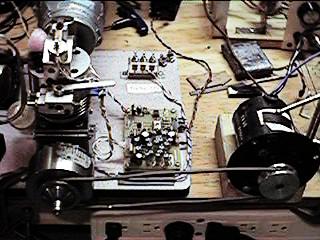EVIC Update #3, December 2000
December 16, 2000
It is just over a year since I made the first sketches of the EVIC 111 Mk1 engine. Since Update #2 was sent out in August I have made improvements to the micro computer software, tried a number of changes to the solenoids, run the engine with a load provided by a DC motor operated as a generator, demonstrated the engine at a number of events and created a book on the engine. 2 weeks ago I switched to a larger micro computer to get 6 more I/O lines to allow further experimenting.
The software improvements correct some bugs in the timing logic that were introducing jitter into the timing and give much better control of the spark timing at slow speed. The spark improvement was done by updating the speed and the hence the spark timing at 40 degrees before TDC. This is when the sensor signal goes low and effectively compensates for the deceleration of the crankshaft that occurs during the compression cycle. This deceleration is much greater at low speed because of less flywheel inertia. As a result low speed operation of the engine is improved.
The experiments with solenoid changes showed that decreasing the mass of the solenoids wasn't going to give any significant improvement in performance. I ran a lot of tests and measured solenoid timing using an automotive timing light and a strobe control circuit I designed. I also made an electro-mechanical position indicator and checked the timing that way. The conclusion was that the liming factor in the current design is the time it takes the valves to close. The valves are not closing as fast as they should. The closing time, especially of the intake valve, decreases with speed because the mixture is being pushed back out of the valve port and, in effect, assists the valve spring in closing the valve. But that means late intake valve closing and less mixture in the cylinder. If you close the exhaust valve early it closes quicker but you don't get all the exhaust gases out. What it all means is that to get better and more consistent breathing I need either stronger valve springs or double acting solenoids. I tried stronger springs but the solenoids are not powerful enough. I have sketched what I think will be a stronger solenoid but I haven't had time to make one yet. Soon I hope. Double acting solenoids will require more complex controls. Maybe in 2001.

Several folks have questioned whether it takes more electrical power to operate the valves than the mechanical power the engine produces. As a result I set out to demonstrate that in fact there is a net power output. I used a 24 volt DC motor driven by a rubber belt as the load. A combination of resistors and automotive light bulbs provided the electrical load. On the first try the DC motor / generator was kicking out about 10 watts of power. The valve solenoids eat up about 20 watts! However a few improvements to the test set up to reduce the mechanical losses and changes so that the electrical load could be easily varied produced positive results on November 18. With the engine running at a steady 4000 RPM I measured a net power output of 15 watts, net of all control, ignition power and mechanical losses. Not much, but I can now answer the question with an authoritative yes.
The EVIC book documents my experiments up to the end of October. Since Bob is going to publish the plans in Strictly IC (in 2001 I hope) I am not advertising the book but I will supply a copy to anyone who really wants one for $30.00US plus $5.00 postage and handling. It includes 17 drawings, schematics, a discussion of the design concepts, step by step building instructions, starting and running and a parts list. I can also supply the assembled and tested electronics for $100.00US. I am currently working on Mk2 electronics (see below) and that is what I would supply.
The PCB I laid out in July accepts both the 8 pin PIC12C509 and the 14 pin PIC16C505. The Mk2 electronics will use the 14 pin micro. The extra I/O lines allowed me to add a second speed/position sensor. The second sensor gives a BDC signal to complement the TDC signal from the first sensor. To use the second senor required a considerable number of changes to the software. The micro's memory was already overflowing so I also had to reduce the amount of code. What at first looked like an easy addition suddenly became a lot of work. The net result was no improvement in performance on the first tests in early December. But it did point the way to another change that eliminated yet another timing bug and gave the best ever engine performance on December 10th.
The next steps will be to try to improve the solenoids and to run some more load tests to see how much power the engine can generate. I have wired a couple of additional switches up the micro and programmed then to give step changes to the valve timing. This should make for some interesting testing after Christmas.
Have a Merry Christmas and all the best for 2001.
Dave Bowes
EVIC home page
Contact Info :
dbowes12@cogeco.ca